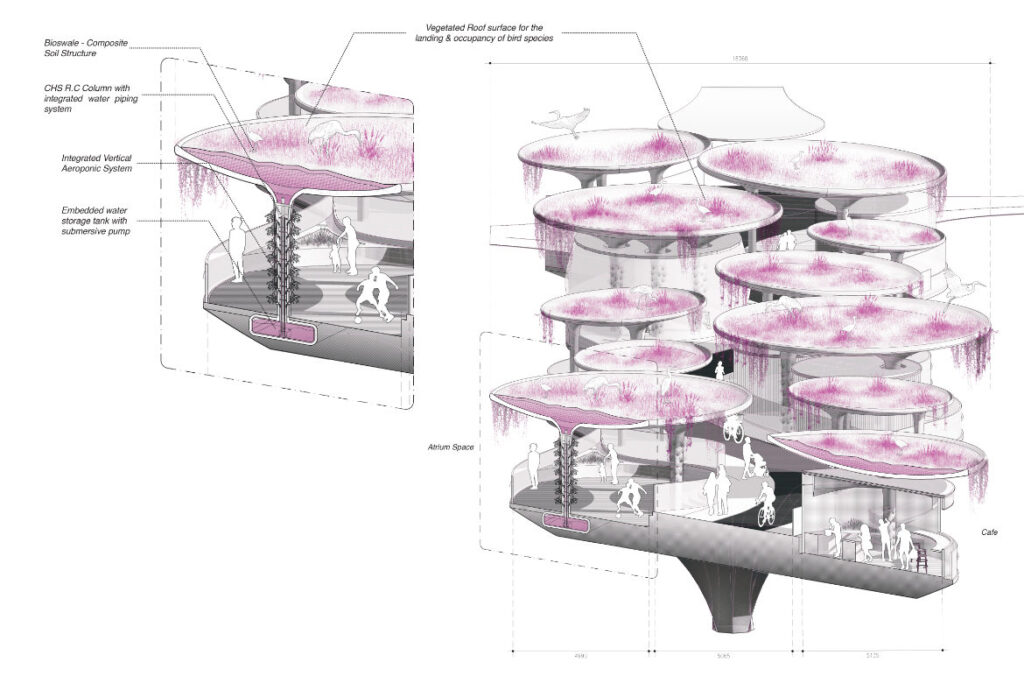An exciting exhibition at National Design Centre offers visionary possibilities for distributed healthcare spurred by emerging technologies.

Healthcare 2030: The Future of Distributed Healthcare exhibition at National Design Centre. Photography by Joanne Wong.
March 22nd, 2022
What if insects could help us manage diabetes? What if every neighbourhood could be dementia friendly? What if you could travel from airport to airport for healthcare? These questions form the premise of Healthcare 2030: The Future of Distributed Healthcare exhibition, showing at National Design Centre till 7 May 2022.
Produced and presented by the students of the Division of Industrial Design and Department of Architecture at the National University of Singapore (NUS), the exhibition showcases five design solutions – ranging from an airport-medical facility to physiotherapy at parks – created as part of their coursework for the Philips-NUS Studio in 2021.
By tapping on increased globalisation and lower cost of travel, HealthAir rethinks the current medical tourism and imagines a network of health systems amongst countries with medical facilities attached to airports for greater access to affordable and high-quality services. A medical wing is introduced to Terminal 4 of Changi Airport, while a medical app better facilitates patients’ onboarding process.


Meanwhile, Forget Us Not is sparked by Singapore’s rapidly ageing population and increased risk of dementia, wherein one in ten people above the age of 60 suffers from it. The project seeks to create inclusive dementia-friendly neighbourhoods using sensors that collect environmental data, which help with detection, diagnosis and progression of the neurological disease.


Similarly, The Nest promotes mental health well-being and identifies early symptoms of depression through the constant collection of data in our environment. The project has three interventions that complement one another: ‘Bao’ the smart companion; Artificial Intelligence (AI) trained mood support; and a series of flexible social spaces around the neighbourhood which are curated for different kinds of engagements.


“These interdisciplinary design solutions were conceived as we researched and worked to address the challenge to explore healthcare as a distributed system in different contexts such as in transit spaces, in the community and in homes,” says Joanne Wong, exhibition organiser and a Year 5 Student at the National University of Singapore’s Department of Architecture. “With the guidance of Philips’ experience designers who co-taught at the Philips-NUS Studio and our lecturers, we’re envisioning a human-centred healthcare system which traverses different scales and experiential touchpoints.”
Wong’s exhibit, The Diabetic Care Hub attempts to offload diabetic prevention and management from hospitals to interconnected satellite care hubs within Singapore’s Park Connector Network. AI and augmented reality technology, inform, incentivise and promote active living and personal involvement.


Another project that sees parks as an ideal environment for decentralising healthcare is FYSIO; simply by reframing physiotherapy as something fun and interactive while tapping into neighbouring communities and healthcare providers as a source of social support.


“The innovation and empathy expressed by these students in their healthcare solutions are inspiring and promising,” says Mark Wee, executive director of DesignSingapore Council. “Through this exhibition, we hope that the public would discover how design can transform healthcare and improve lives.”
Admission to Healthcare 2030: The Future of Distributed Healthcare is free from 9am to 9pm daily.
A searchable and comprehensive guide for specifying leading products and their suppliers
Keep up to date with the latest and greatest from our industry BFF's!

Marylou Cafaro’s first trendjournal sparked a powerful, decades-long movement in joinery designs and finishes which eventually saw Australian design develop its independence and characteristic style. Now, polytec offers all-new insights into the future of Australian design.

Savage Design’s approach to understanding the relationship between design concepts and user experience, particularly with metalwork, transcends traditional boundaries, blending timeless craftsmanship with digital innovation to create enduring elegance in objects, furnishings, and door furniture.

The Sub-Zero Wolf showrooms in Sydney and Melbourne provide a creative experience unlike any other. Now showcasing all-new product ranges, the showrooms present a unique perspective on the future of kitchens, homes and lifestyles.

Sub-Zero and Wolf’s prestigious Kitchen Design Contest (KDC) has celebrated the very best in kitchen innovation and aesthetics for three decades now. Recognising premier kitchen design professionals from around the globe, the KDC facilitates innovation, style and functionality that pushes boundaries.

An outstanding line-up of participants will contribute to a beautifully curated exhibition in Thailand that delves deep into the collective thinking of architecture in our region and helps set a progressive agenda for the future of design.

Salone del Mobile 2024 is only a few weeks away, so we’re highlighting here seven special events, spaces and installations that we’re certainly planning to check out.
The internet never sleeps! Here's the stuff you might have missed

Third in the series of boutique hotels under the Lloyd’s Inn brand, Lloyd’s Inn Kuala Lumpur bring the immediacy of nature to the new high-rise hospitality experience in the heart of a bustling city.

From the trailblazer of Spanish industrial design comes a new collection of recycled rugs – a powerful exploration of the concept of waste, a keen celebration of imperfection, and a new underfoot symbol of responsible design.